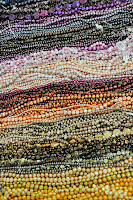Have you noticed that searching for Pearls today feels very much like Johnny Depp’s quest for the Black Pearland leaves you asking the same question he wanted to know about the rum, “Where have all the pearls gone?” We certainly noticed, so we went on a quest to find the answer. Turns out is not as simple as we were originally led to believe.
According to one of our vendors, the Japanese pearl beds were hard hit by the tsunamis and subsequent radiation leaks, and it destroyed Japan’s oysters. While there were a couple of initial reports that this “could” be a problem, most reports coming from Japan say that the oyster beds were in the south & west of Japan where the tsunami didn’t have a primary impact. So that still leaves us asking, “Where have all the pearls gone?”
Perhaps the answers lay less in environmental factors and more in economic factors. It takes 18-36 months to grow a decent quality pearl. Even the lowest quality pearls (some would be hard-put to use the word “quality” at all) take a minimum of 8 months to grow. China is the number one producer of freshwater pearls in the world. As the US bead market grew, Chinese growers produced like crazy, shortening the growing times and flooding the bead market with low quality freshwater pearls. Pearls were everywhere! And prices were low, low, low as vendors practically beat each other up vying for our business. And like the tide, where there is a flow, there must be an ebb. Where there is low profitability, a slowdown or cease in production will inevitably follow.
And the Chinese bead producers found a new love – crystal! Crystal – faster to produce than pearls – you don’t have to GROW them – has the sparkle of money. And there are always rocks – they are already there. They just have to be dug out, shaped and polished. And that leaves us with what we saw at the Gem & Jewelry Show this past weekend – nearly every vendor was Chinese and most of them had only low quality “semi-precious” and crystal beads. The pearls that were there appeared to be leftovers from years gone by – very large, weird colors, or extremely rough quality.
So will the inexpensive freshwater pearls we had become accustomed to be back? It’s anyone’s guess. (We could start a pool and see who turns out right in 3 years or so.) If pearl beds were allowed to die, the mollusks will have to be re-cultivated, and pearl growing resumed. Our vendor predicted at least 3 years (the ideal time to grow a pearl) before we see pearls back on the market. Even if easy-to-find pearls do reenter the market, it is likely that we will never again see the rock bottom prices and easy pickin’s of the past.
Bottom line, enjoy the pearls you have, and expect to pay higher prices for pearls for the foreseeable future, as we all wait to see whether pearls will make a rebound in a few years or not.
1 Stop Bead Shop has a small supply of reasonably priced ($6-$12 strands) ivory freshwater pearls still in stock… while supply lasts.
Wednesday, March 14, 2012
Subscribe to:
Post Comments (Atom)








No comments:
Post a Comment